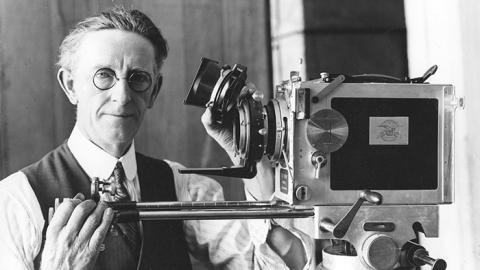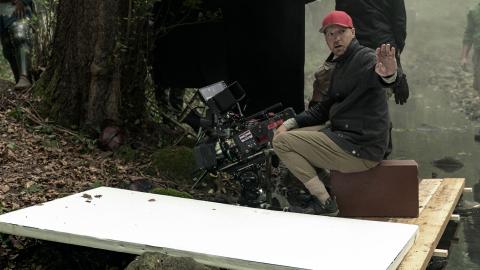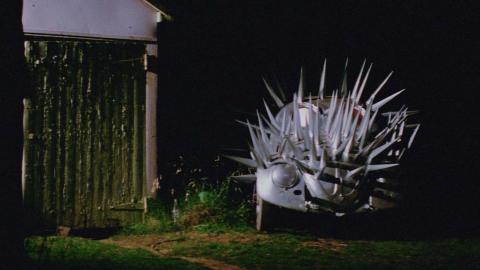

The Shadowcatchers
The Shadowcatchers: a history of cinematography in Australia’ (2012) by Martha Ansara is a stylish coffee-table book which is being launched this month. Martha describes part of the journey she has taken with the NFSA and the national audiovisual collection to find some of the beautiful images that accompany her work.
Main image: 'Kakadu Man’ (1989) Film Australia, National Interest Program. Kakadu National Park, Northern Territory. John Hosking (cinematographer). Courtesy Film Australia Library, National Film and Sound Archive

Sometime in 2008, I found myself on a bus in the industrial outskirts of Canberra, traveling to the fabled vaults of the National Film and Sound Archive. I was looking forward to my journey’s end and looking back also to the beginnings of this trip, which started many years previously, when the NFSA had not long been in existence. The sleek new building wasn’t even thought of then and the Archive seemed to consist of a heap of uncatalogued boxes of goodness knows what, dumped into the shabby old Institute of Anatomy, with here and there an archivist clinging to a cluttered desk, puzzling over a stack of index cards. I remember being led up some stairs to a narrow mezzanine which overlooked one of these strange storage/work spaces. It was lined on one-and-a-half sides with filing cabinets, and in these filing cabinets was the photographic collection – all kinds of photographs, as alphabetically arranged as possible, and often having little more identification than a title. I think it took me a day to look through every drawer in every cabinet in search of photographs relating to the film oral histories I was recording, but I can no longer remember what I found.
So here I was again, perhaps 20 years later, traversing the wilds of Mitchell to continue my search. My oral history work had been transformed into a photographic history of Australian cinematography, entitled The Shadowcatchers, soon to be published (or so we thought) by the Australian Cinematographers Society (ACS). And by this time, the digitisation of the Archive’s photographic collection had begun and images could be easily viewed through an elegant online catalogue. Meanwhile, however, the collection had expanded – as collections do – and I found that within the vaults the grey filing cabinets still existed and there were many more of them than ever before. In fact, it took me a week, flipping as fast as I could through neatly arranged drawers of photographs, to identify the wonderful production stills which would fill out the history which the NFSA’s digitised images were already contributing to the book. The photos – covering the period from 1901 to the present – were all now beautifully catalogued, but again some had only a title and many of the people in them remained unidentified.
At any rate, over the next year or more the Archive scanned the selected photographs for us, upgrading those that had previously been scanned at too low a resolution at the beginning of the digitisation program. Amanda McCormack, who looks after Access, patiently sent them on to us – again and again. Today’s digital technology moves so fast that everything is out of date almost as soon as the work on it has been completed and as cinematographers have high standards for images, we were nothing if not demanding. Eventually, I paid another visit to the NFSA to talk with digitisation specialist Darren Weinert who, like so many Archive workers, is more than a technician, having a great enthusiasm and a broad knowledge of his field. He then located the absolutely best originals of some photos and scanned again … and eventually, the layout for the book began.
But this was hardly the end of our efforts. We had earlier looked through the NFSA holdings of oral history interviews for those that had been transcribed (we were running out of puff and further transcribing was out of the question) to find just the right anecdote to bring our historical text alive. But even though the anecdotes were now in place, along with the historical text and all the photos, the ACS Book Committee was still faced with writing captions. How I wish that we had been more strenuous in our efforts in the 1980s to organise identification of photographs by veteran filmmakers! By 2011 few of these pioneers were still alive and in most cases our long hours of detection failed to yield conclusive results. A quarter of the photographs in The Shadowcatchers come from the NFSA, and of these most were taken on film sets prior to the 1950s, and too many of our captions are peppered with the word ‘unknown’. Surprisingly, we found that it was equally as difficult to extract caption information from the cinematographers and photographers who sent us photographs from the present era. It is hard for busy people to understand the importance of accurate identification; but today’s material which we think of as just another film or just another document, soon becomes a precious historical artefact —or not, if it lacks proper information.
Eventually, of course, the book was all laid out and ready for printing – but that’s another saga which I won’t burden you with now. We changed printers in the end and happily were offered a fifth colour (books traditionally print in four) and the resulting rich blacks are a cinematographer’s dream. The books are arriving by ship just in the nick of time for our big launch and industry party on 31 May 2012. (Yet another saga there too!) We’ve seen the advance copies and are delighted. We hope the NFSA will be too – the Archive’s contribution cannot be over estimated. And the patience of archivists, which seems to be integral to the archiving mentality, is something the ACS book committee deeply appreciates.
For me, The Shadowcatchers is, among other things, a tribute to the importance of the NFSA to our national heritage – to our understanding of the past. The NFSA was established originally with very active support from Australia’s filmmaking community. It is in the Archive that our work lives on for future generations, and ensuring that it does so in a meaningful way is a far more complex operation than most of us on the outside understand. Cinematographers owe a big debt to the women and men of the NFSA for their skills and their willingness to tackle such an enormous task.
The National Film and Sound Archive of Australia acknowledges Australia’s Aboriginal and Torres Strait Islander peoples as the Traditional Custodians of the land on which we work and live and gives respect to their Elders both past and present.


